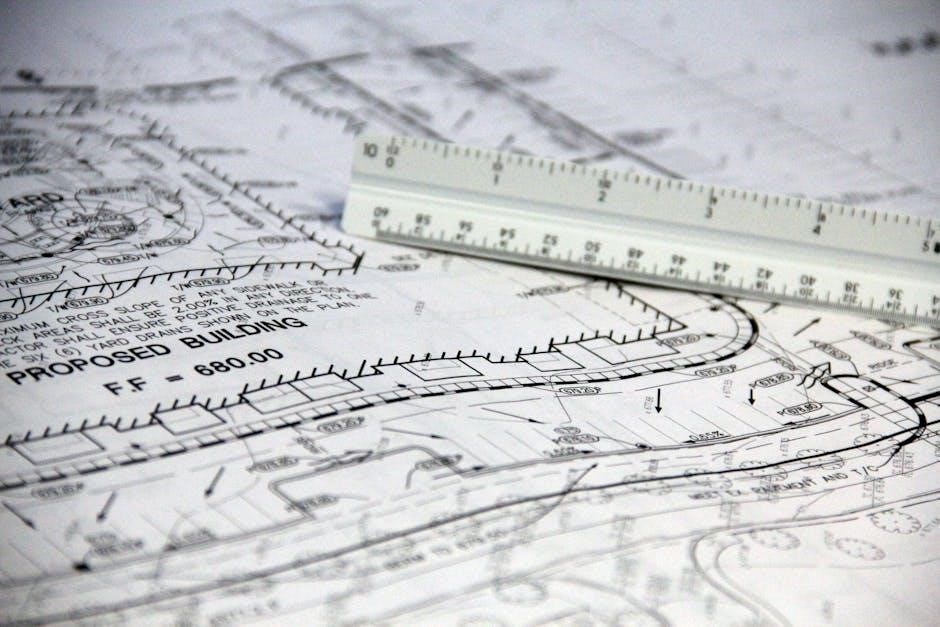Congruence and similarity are fundamental concepts in geometry, defining how shapes relate in terms of size and shape. Congruent figures are identical in shape and size, while similar figures have the same shape but different sizes, often explored through ratios and transformations.
1.1 Understanding Congruence in Geometry
Congruence in geometry refers to the relationship between two shapes that are identical in both shape and size. This means all corresponding sides and angles are equal. Congruent triangles, for example, have matching side lengths and angle measures, making them perfect copies of each other. The concept is crucial for solving geometric proofs and problems, as it allows mathematicians to establish equivalence between figures. Criteria such as SSS (Side-Side-Side), SAS (Side-Angle-Side), ASA (Angle-Side-Angle), and AAS (Angle-Angle-Side) are used to determine congruence, ensuring precision in geometric analysis.
1.2 Exploring Similarity in Geometry
Similarity in geometry refers to the relationship between shapes that have the same shape but not necessarily the same size. This means their corresponding angles are equal, and their sides are proportional. Similar triangles, for instance, maintain equal angle measures and have side lengths in a consistent ratio. The Angle-Angle (AA) similarity criterion is often used to prove similarity, as two angles of one triangle equal to two angles of another triangle ensure similarity. This concept is vital in scaling shapes and solving real-world problems involving proportions and ratios.
Criteria for Triangle Congruence
Congruent triangles have identical shapes and sizes, with corresponding sides and angles equal. Common criteria include SSS, SAS, ASA, AAS, and HL, ensuring triangles match perfectly.
2.1 Side-Angle-Side (SAS) Congruence

The SAS (Side-Angle-Side) congruence theorem states that two triangles are congruent if two sides and the included angle of one triangle are equal to the corresponding sides and included angle of the other triangle. This criterion is widely used in geometry to prove triangle congruence, ensuring that the triangles are identical in shape and size. It is particularly useful when two sides and the angle between them are known, making it a reliable method for verifying congruence in various geometric problems and proofs.
2.2 Side-Side-Side (SSS) Congruence
The Side-Side-Side (SSS) Congruence Theorem states that if three sides of one triangle are equal to the corresponding three sides of another triangle, the triangles are congruent. This fundamental criterion ensures that the triangles are identical in shape and size, making it a reliable method for verifying congruence; SSS Congruence is particularly useful when all three sides are known, providing a straightforward way to prove triangle congruence without relying on angles. It is widely applied in solving geometric problems and proofs, emphasizing its importance in geometry.
2.3 Angle-Side-Angle (ASA) Congruence
The Angle-Side-Angle (ASA) Congruence Theorem asserts that if two angles and the included side of one triangle are equal to the corresponding two angles and the included side of another triangle, the triangles are congruent. This theorem is particularly useful in scenarios where angle measures are known, providing a clear method to establish triangle congruence. ASA is a reliable criterion, ensuring that the triangles are identical in shape and size, and is extensively used in geometric proofs and problem-solving, highlighting its practical application in various contexts.
2.4 Angle-Angle-Side (AAS) Congruence
The Angle-Angle-Side (AAS) Congruence Theorem states that if two angles of one triangle are equal to two angles of another triangle, and the non-included sides are equal, the triangles are congruent. This criterion is valid because the third angle in each triangle will automatically be equal, as the sum of angles in a triangle is always 180 degrees. AAS is a reliable method for proving congruence, especially when two angles and a side are known, making it a valuable tool in geometric proofs and problem-solving scenarios.
2.5 Hypotenuse-Leg (HL) Congruence
The Hypotenuse-Leg (HL) Congruence Theorem applies specifically to right-angled triangles. It states that if the hypotenuse and one leg of one right triangle are congruent to the hypotenuse and the corresponding leg of another right triangle, then the triangles are congruent. This theorem is a special case of congruence, relying on the properties of right triangles, where the hypotenuse and leg lengths uniquely determine the triangle’s size and shape. HL Congruence is particularly useful in proofs involving right-angled triangles and their corresponding sides.

Proving Triangle Congruence
Proving triangle congruence involves establishing that two triangles are identical in shape and size. This is done using theorems like SSS, SAS, ASA, AAS, and HL, ensuring corresponding sides and angles match, confirming triangles are congruent.
3.1 Using the SSS Congruence Theorem
The Side-Side-Side (SSS) Congruence Theorem states that if three sides of one triangle are equal to three sides of another triangle, the triangles are congruent. This theorem is useful for proving congruence when side lengths are known. For example, in triangles ABC and XYZ, if AB = XY, BC = YZ, and AC = XZ, then triangle ABC is congruent to triangle XYZ by SSS. Worksheets often include problems requiring the application of this theorem to verify triangle congruence.
3.2 Applying the SAS Congruence Theorem
The Side-Angle-Side (SAS) Congruence Theorem states that if two sides and the included angle of one triangle are equal to two sides and the included angle of another triangle, the triangles are congruent. This theorem is particularly useful when two sides and the angle between them are known. For instance, in triangles ABC and DEF, if AB = DE, BC = EF, and angle B equals angle E, then triangle ABC is congruent to triangle DEF by SAS. Worksheets often include problems that require identifying and applying this theorem to establish triangle congruence.
3.3 Utilizing the ASA and AAS Theorems
The ASA (Angle-Side-Angle) and AAS (Angle-Angle-Side) theorems are essential for proving triangle congruence. ASA states that if two angles and the included side of one triangle are equal to two angles and the included side of another, the triangles are congruent. AAS, a special case of ASA, requires two angles and a non-included side to establish congruence. These theorems are often applied in worksheet problems where angle and side relationships are provided to verify triangle congruence.
3.4 Proving Congruence with HL Theorem
The Hypotenuse-Leg (HL) Theorem is a specialized tool for proving congruence in right-angled triangles. It states that if the hypotenuse and one leg of a right triangle are congruent to the hypotenuse and one leg of another right triangle, then the triangles are congruent. This theorem simplifies proofs involving right triangles, as it directly links corresponding sides and angles without requiring additional angle or side comparisons. Worksheets often include problems leveraging the HL Theorem to verify triangle congruence efficiently.

Triangle Similarity and Ratios
Triangle similarity involves comparing shapes with proportional sides and equal corresponding angles. Ratios of sides determine similarity, while the Side-Splitter Theorem and AA Theorem establish related criteria.
4.1 Understanding the Basic Ratio Concept
The ratio concept is central to similarity, defining proportional relationships between corresponding sides of triangles. Ratios are expressed as fractions, ensuring consistency across similar figures. For instance, if one triangle has sides in the ratio 3:4:5, a similar triangle might have sides in the ratio 6:8:10, maintaining the same proportion. This fundamental understanding is crucial for applying similarity theorems and solving real-world problems involving scale models or enlargements. Worksheets often include exercises where students practice identifying and creating equivalent ratios, reinforcing their grasp of proportional relationships in geometry.
4.2 Applying the Side-Splitter Theorem
The Side-Splitter Theorem states that if a line parallel to one side of a triangle intersects the other two sides, it divides those sides proportionally. This theorem is crucial for establishing similarity between triangles. For example, in triangle ABC, if a line DE is parallel to BC and intersects AB and AC at points D and E, then AD/DB = AE/EC. Worksheets often include problems where students apply this theorem to prove similarity or find unknown segment lengths, reinforcing their understanding of proportional relationships in geometry.
4.3 Using the AA (Angle-Angle) Similarity Theorem
The AA Similarity Theorem states that if two angles of one triangle are congruent to two angles of another triangle, the triangles are similar. This theorem is widely used in geometry to prove similarity, as only two angles need to be compared. Worksheets often include problems where students apply this theorem to determine if triangles are similar, calculate missing angles, or find proportional sides. This concept is essential for understanding triangle relationships and solving real-world geometry problems effectively.
4.4 Understanding the SSS and SAS Similarity Theorems
The SSS (Side-Side-Side) and SAS (Side-Angle-Side) Similarity Theorems are essential for proving triangle similarity. SSS states that if three sides of one triangle are proportional to another triangle’s sides, the triangles are similar; SAS requires two sides and the included angle to be proportional. Both theorems simplify proving similarity by focusing on side ratios and included angles, eliminating the need to compare all angles. Worksheets often include exercises applying these theorems to real-world geometry problems, reinforcing their practical applications in fields like engineering and art.

Real-World Applications of Congruence and Similarity
Congruence and similarity are vital in architecture, engineering, art, and physics. They enable precise designs, scale models, and proportional representations, ensuring structural integrity and aesthetic balance.
5.1 Architecture and Engineering Applications
In architecture and engineering, congruence ensures identical structural components, while similarity aids in scaling designs. Blueprint models use proportional relationships to maintain accuracy. This ensures stability, functionality, and aesthetic consistency, allowing precise replication of designs and maintaining proportional integrity in scaled structures.
5.2 Art and Design Uses
Congruence and similarity are essential tools in art and design, enabling the creation of balanced compositions and proportionate visuals. Artists use congruent shapes for symmetry, while similar figures help scale designs without losing aesthetic appeal. Graphic designers leverage these principles to craft logos and patterns, ensuring visual harmony and consistency. These geometric concepts inspire creativity, allowing for precise replication and proportionate scaling in various artistic projects and designs.
5.3 Physics and Mechanics Applications
Congruence and similarity play vital roles in physics and mechanics, particularly in structural analysis and design. Congruent shapes ensure identical mechanical properties, crucial for predictable behavior under stress. Similarity principles enable scaling of models to test and predict real-world performance, such as in aerospace engineering. These concepts are also fundamental in robotics for designing proportional systems and in understanding equilibrium states, making them indispensable tools in both theoretical and applied physics scenarios.
Practice Worksheets with Answers
Downloadable congruence and similarity worksheets with answers provide structured practice for students. These resources cover various grade levels, ensuring mastery of geometry concepts through guided exercises and solutions.
6.1 Solving Congruence Problems
Congruence problems often involve proving triangles are congruent using theorems like SAS, ASA, or SSS. Worksheets provide exercises where students identify corresponding parts, apply postulates, and justify their reasoning. Answer keys offer step-by-step solutions, helping learners understand common pitfalls and master proof techniques. These resources cover various difficulty levels, ensuring a comprehensive understanding of congruence criteria and their practical applications in geometry.
6.2 Solving Similarity Problems
Similarity problems focus on identifying and applying similarity criteria, such as AA, SAS, and SSS similarity theorems. Worksheets include exercises on proportional sides, equal angles, and real-world applications like scaling objects. Answer keys provide detailed solutions, highlighting how to set up ratios and verify similarity. These exercises help students master concepts like similarity transformations and proportional reasoning, essential for advanced geometry topics and practical problem-solving scenarios.
6.3 Mixed Congruence and Similarity Exercises
Mixed exercises combine both congruence and similarity concepts, testing students’ ability to identify and apply the correct criteria. Worksheets include problems involving triangle identification, proportionality, and real-world applications. Students practice using theorems like SAS, SSS, AA, and ASA for congruence, and similarity ratios for scaling shapes. Answer keys provide step-by-step solutions, reinforcing problem-solving strategies and ensuring mastery of both concepts. These exercises prepare students for advanced geometry challenges by integrating theoretical knowledge with practical skills.



